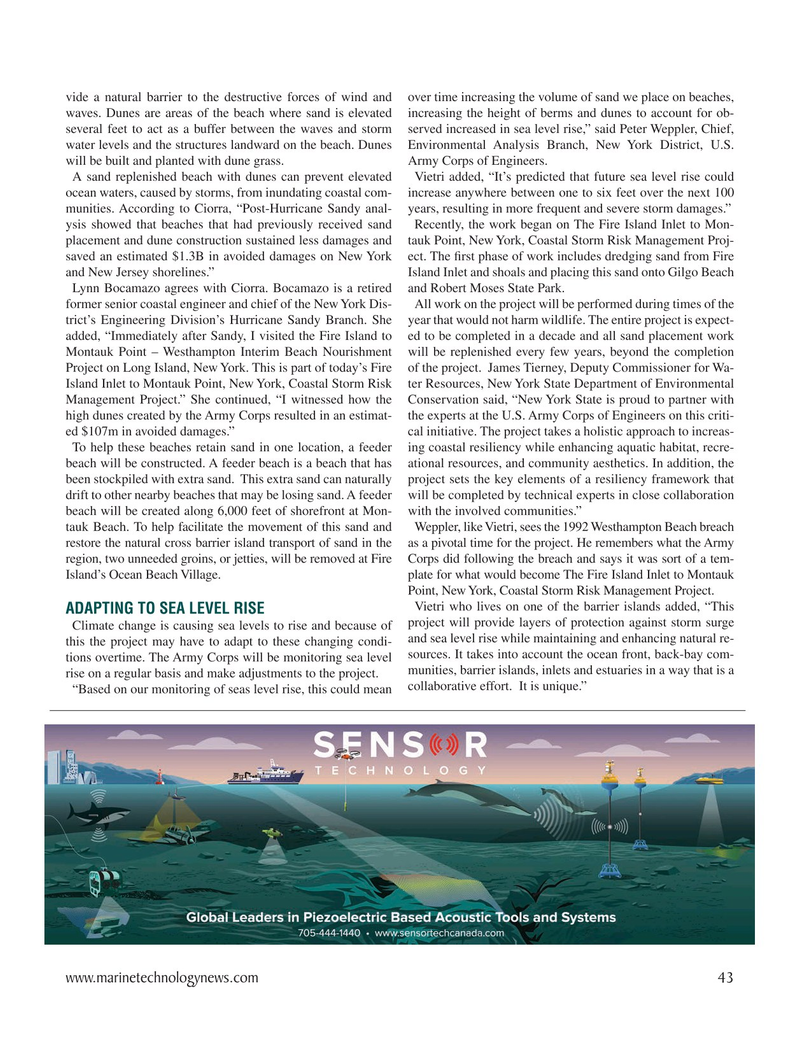
Page 43: of Marine Technology Magazine (March 2022)
Read this page in Pdf, Flash or Html5 edition of March 2022 Marine Technology Magazine
vide a natural barrier to the destructive forces of wind and over time increasing the volume of sand we place on beaches, waves. Dunes are areas of the beach where sand is elevated increasing the height of berms and dunes to account for ob- several feet to act as a buffer between the waves and storm served increased in sea level rise,” said Peter Weppler, Chief, water levels and the structures landward on the beach. Dunes Environmental Analysis Branch, New York District, U.S. will be built and planted with dune grass. Army Corps of Engineers.
A sand replenished beach with dunes can prevent elevated Vietri added, “It’s predicted that future sea level rise could ocean waters, caused by storms, from inundating coastal com- increase anywhere between one to six feet over the next 100 munities. According to Ciorra, “Post-Hurricane Sandy anal- years, resulting in more frequent and severe storm damages.” ysis showed that beaches that had previously received sand Recently, the work began on The Fire Island Inlet to Mon- placement and dune construction sustained less damages and tauk Point, New York, Coastal Storm Risk Management Proj- saved an estimated $1.3B in avoided damages on New York ect. The ? rst phase of work includes dredging sand from Fire and New Jersey shorelines.” Island Inlet and shoals and placing this sand onto Gilgo Beach
Lynn Bocamazo agrees with Ciorra. Bocamazo is a retired and Robert Moses State Park.
former senior coastal engineer and chief of the New York Dis- All work on the project will be performed during times of the trict’s Engineering Division’s Hurricane Sandy Branch. She year that would not harm wildlife. The entire project is expect- added, “Immediately after Sandy, I visited the Fire Island to ed to be completed in a decade and all sand placement work
Montauk Point – Westhampton Interim Beach Nourishment will be replenished every few years, beyond the completion
Project on Long Island, New York. This is part of today’s Fire of the project. James Tierney, Deputy Commissioner for Wa-
Island Inlet to Montauk Point, New York, Coastal Storm Risk ter Resources, New York State Department of Environmental
Management Project.” She continued, “I witnessed how the Conservation said, “New York State is proud to partner with high dunes created by the Army Corps resulted in an estimat- the experts at the U.S. Army Corps of Engineers on this criti- ed $107m in avoided damages.” cal initiative. The project takes a holistic approach to increas-
To help these beaches retain sand in one location, a feeder ing coastal resiliency while enhancing aquatic habitat, recre- beach will be constructed. A feeder beach is a beach that has ational resources, and community aesthetics. In addition, the been stockpiled with extra sand. This extra sand can naturally project sets the key elements of a resiliency framework that drift to other nearby beaches that may be losing sand. A feeder will be completed by technical experts in close collaboration beach will be created along 6,000 feet of shorefront at Mon- with the involved communities.” tauk Beach. To help facilitate the movement of this sand and Weppler, like Vietri, sees the 1992 Westhampton Beach breach restore the natural cross barrier island transport of sand in the as a pivotal time for the project. He remembers what the Army region, two unneeded groins, or jetties, will be removed at Fire Corps did following the breach and says it was sort of a tem-
Island’s Ocean Beach Village. plate for what would become The Fire Island Inlet to Montauk
Point, New York, Coastal Storm Risk Management Project.
Vietri who lives on one of the barrier islands added, “This
ADAPTING TO SEA LEVEL RISE
Climate change is causing sea levels to rise and because of project will provide layers of protection against storm surge and sea level rise while maintaining and enhancing natural re- this the project may have to adapt to these changing condi- tions overtime. The Army Corps will be monitoring sea level sources. It takes into account the ocean front, back-bay com- munities, barrier islands, inlets and estuaries in a way that is a rise on a regular basis and make adjustments to the project. “Based on our monitoring of seas level rise, this could mean collaborative effort. It is unique.” www.marinetechnologynews.com 43
MTR #3 (34-49).indd 43 2/25/2022 10:13:49 AM

 42
42

 44
44
